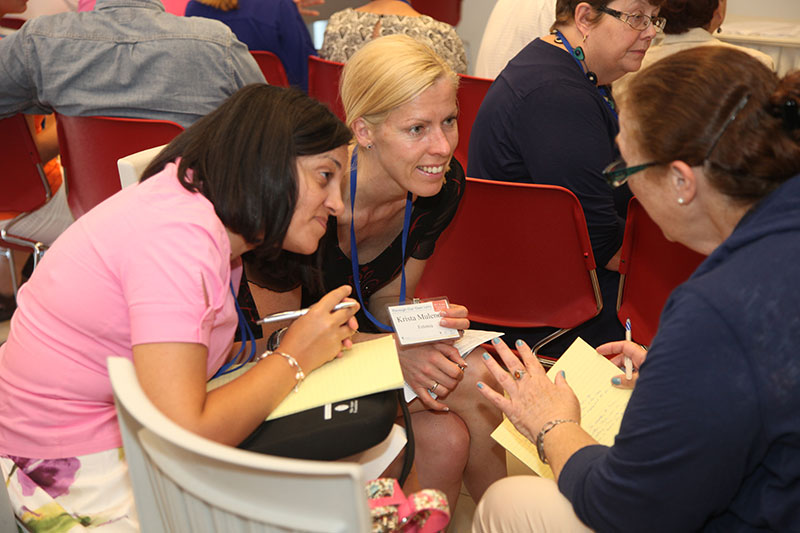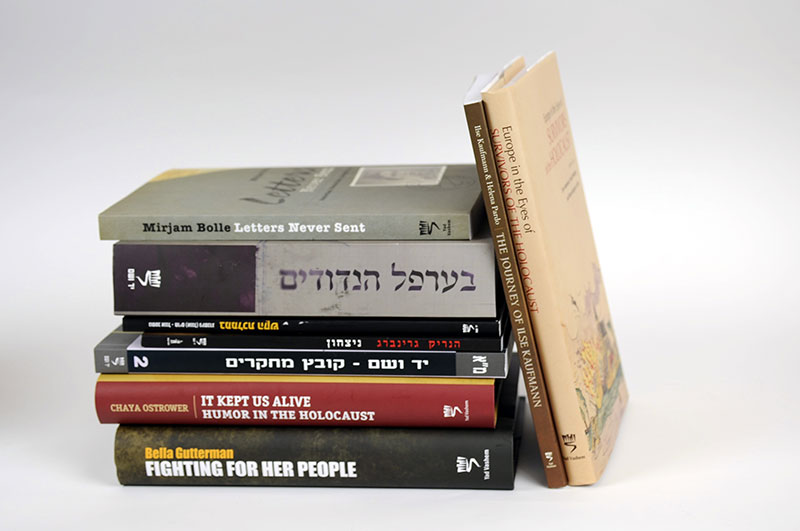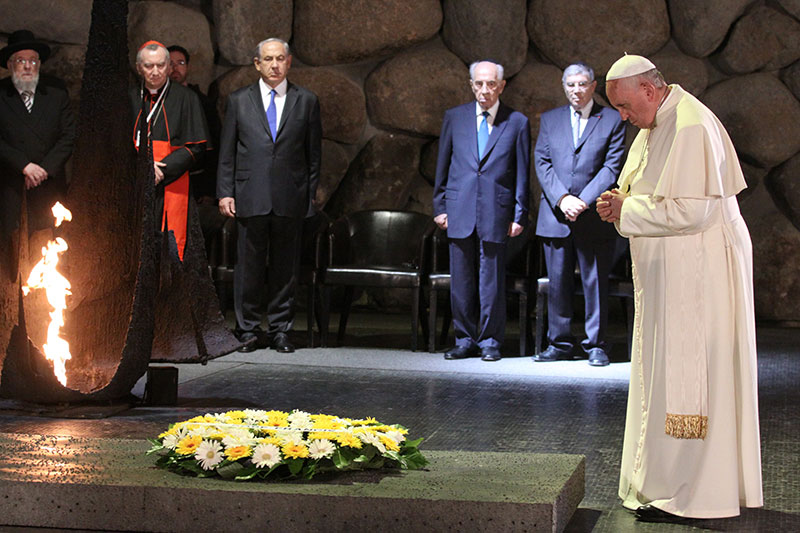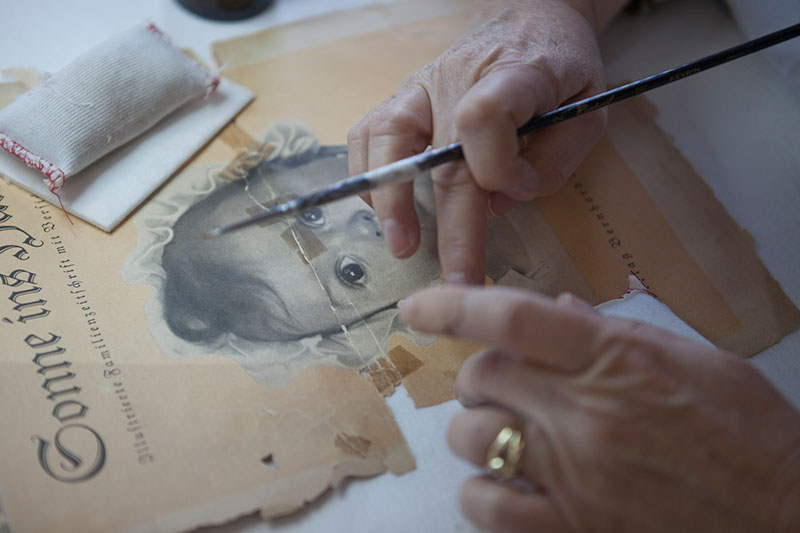Holocaust Education – The International School
- More than 304,000 students from Israel and abroad, soldiers and officers of the IDF and other Israeli security forces participated in seminars and programs of the International School for Holocaust Studies and at the School’s branch in Givatayim.
- 70 long-term seminars were held at Yad Vashem for some 1,500 educators from abroad. Some 110 youth participated in 5 international courses for Jewish leadership.
- Some 1,100 foreign educators participated in 53 teacher-training days at the School.
- 89 seminars were conducted for some 2,700 Israeli teachers.
- Some 10,100 Israeli educators attended 320 teacher-training days at Yad Vashem and throughout Israel. Among these were some 3,500 ultra-Orthodox teachers.
- More than 1,000 ultra-Orthodox teachers participated in 3 special teacher-training days for ultra-Orthodox educators at Yad Vashem.
- 85 school staff members, together with School graduates around the world, participated in seminars, conferences and international forums and worked in some 35 different countries worldwide.
- More than 450 educators from 50 countries participated in the 9th International Conference for Holocaust Educators.
- More than 3,800 teachers across the US received training as part of “Echoes and Reflections,” a joint project of Yad Vashem, the ADL and the USC Shoah Foundation Institute. Some 24,000 educators and community leaders have been trained since the inception of the program.
- An extensive range of educational material in 15 different languages was uploaded to the Virtual School on the Yad Vashem website, including lesson plans, interactive maps, educational environments and testimonies.
- 8 films were produced, totaling 90 minutes of video that are included in the Holocaust Education Video Toolbox, a special educational platform developed by the Virtual School.
- More than 650 individuals participated in online courses conducted in 5 languages. Also added to the website were lesson plans and sub-sites for special events, including curricula marking special occasions such as Holocaust Remembrance Day and International Holocaust Remembrance Day.
Research and Publications
- The International Institute for Holocaust Research granted the 4th annual Yad Vashem International Book Prize for Holocaust Research in memory of Abraham Meir Schwarzbaum, Holocaust survivor, and his family members murdered in the Holocaust. The 2014 recipient was Prof. Jan Grabowski for his book, Hunt for the Jews: Betrayal and Murder in German-Occupied Poland.
- The International Institute for Holocaust Research held an International conference, 5 international research workshops and 24 workshops for Holocaust scholars; the annual lecture of The John Najmann Chair of Holocaust Studies; and the first annual lecture in memory of Prof. David Bankier. The Institute held an international conference in partnership with the Western Galilee College and Ghetto Fighters' House, and assisted in organizing an international conference at Szeged University in Hungary.
- 13 senior researchers from Israel and abroad were hosted at Yad Vashem as postdoctoral fellows, and 4 as research fellows, under the auspices of the EHRI program.
- The Institute granted 15 awards to Master's and Doctoral students studying in Israel, and 3 awards to Doctoral students who came to Yad Vashem from abroad.
- 30 new publications were released by Yad Vashem, including 14 research studies, 7 memoirs, 5 diaries and 4 volumes of Yad Vashem Studies.
Artworks and Artifacts
- The new traveling exhibition "Shoah – How Was It Humanly Possible?" opened in the UN Visitors Lobby in New York.
- 1,053 artifacts and 144 works of art were added to Yad Vashem’s collections. The Artifacts Collection now holds more than 28,600 items and the Art Collection comprises more than 9,300 pieces.
- Traveling exhibitions were displayed in 9 countries worldwide. 41 versions of 13 exhibitions are now available in 13 languages: English, French, German, Spanish, Flemish, Ukrainian, Russian, Portuguese, Finnish, Latvian, Italian, Greek and Arabic.
Righteous Among the Nations
- 410 individuals were recognized as Righteous Among the Nations. As of the end of 2014, more than 25,680 individuals have been awarded the title.
Visits and Commemorative Events
- Some 900,000 people visited Yad Vashem in 2014.
- More than one-third of Yad Vashem's visitors were guided by its professional guiding staff, among them more than 760 world leaders, dignitaries and official visitors who toured Yad Vashem.
- The Commemoration and Public Relations Division held some 75 events, including the Holocaust Remembrance Day and VE Day ceremonies in conjunction with Holocaust survivor and next-generation organizations. More than 230 memorial services were conducted during 2014.
Internet Activity
- Close to 14 million visits from some 220 countries and territories were recorded in 2014 on the Yad Vashem website.
- Over 9.4 million video views have been recorded on Yad Vashem's YouTube channels in English, Hebrew, Spanish, Farsi, Russian, Arabic and German since their launch.
- More than 25,000 individuals joined Yad Vashem's Facebook page, bringing the total number of members to more than 102,400.
- More than 4,280 individuals became new followers of Yad Vashem on Twitter. More than 11,500 people now follow the Twitter feed.
- Yad Vashem's website won the 2014 "People and Computers" Magazine's Special Category WebiAward.
Documentation, Photographs, Names, Testimonies and Films
- Some 10 million pages of Holocaust-era documentation were gathered by Yad Vashem. To date, Yad Vashem’s Archives, the largest and most comprehensive repository of its kind, contain some 179 million pages of documentation.
- Some 1.5 million pages of original Holocaust documentation and some 4.5 million pages of microfilmed documentation were digitized.
- The Archives operated an Israeli national center for the digital backup of Holocaust documentation. In 2014, the center scanned and provided digital backup for some 50,000 pages of documentation housed at two leading Holocaust archives in Israel.
- Yad Vashem has identified more than two-thirds of the victims of the Holocaust. The Central Database of ShoahVictims’ Names now contains 4.5 million names of Holocaust victims, all of which are accessible online. The source of more than half the total number of names in the Names Database is over 2.6 million Pages of Testimony, while the remainder is from archival lists and documents.
- The Shoah Victims' Names Recovery Project gathered 103,000 names, some 21,000 from Pages of Testimony. The Names Recovery Project utilizes a network of volunteers around the world (organizations and individuals) to collect names of Holocaust victims. Its focus is on the missing names from the FSU and from the ultra-Orthodox community, as well as Jewish commemorative sources: religious books, memorial plaques and the tombstones of survivors upon which are engraved the names of family members who were murdered in the Holocaust.
- Some 700,000 names were added to the computerized database listing Jewish Soviet citizens who were evacuated during World War II and forced to move eastwards.
- Staff of the Gathering the Fragments campaign to rescue personal items from the Holocaust era collected some 40,000 items – documents, diaries, photographs, artifacts and artworks – from some 1,280 individuals in 23 centralized collection days and 312 home collections. Since the project was launched in April 2011, more than 144,000 items have been received from 7,000 individuals.
- Some 19,000 photographs were added to the Archives Division, among them some 3,000 to the Hall of Names. Yad Vashem currently houses some 450,000 photographs, including some 151,000 photographs attached to Pages of Testimony and housed in the Hall of Names.
- Some 300,000 photographs are easily accessible to the general public on the Yad Vashem website. Of these, approximately half are available on a new interface and half are attached to Pages of Testimony and accessible on the Central Database of Shoah Victims’ Names.
- Some 1,100 new Holocaust survivor testimonies were filmed and recorded by the Oral History Section, Archives Division, aided by an outreach program enabling survivors to have their testimonies filmed at home. Some additional 4,400 testimonies recorded elsewhere were also acquired. The Archives currently house some 125,500 video, audio and written testimonies.
- Some 28,000 public inquiries were answered by the Reference and Information Services Unit. Of these inquiries, some 8,000 members of the public were assisted in the Library and Archives Reading Room, and some 20,000 were written queries.
- Yad Vashem's Library, the most comprehensive collection of published material about the Holocaust, now holds over 150,000 titles in 54 languages.
- The Visual Center acquired more than 930 films, including classics from the past as well as new films, and catalogued more than 700 from a variety of genres. The searchable online Film Catalogue now includes more than 9,500 titles, all of them easily accessible on Yad Vashem's website. Currently more than two-thirds of these titles, some 6,600 films, are available for viewing at the Visual Center.
- In addition to thousands of visitors to the Visual Center, more than 75 groups of students, teachers and film directors took part in Holocaust-related film programs, including lectures on film and the Holocaust. The Visual Center held 20 special screenings of films for the general public at commemorative events and film festivals in Israel and around the world, as well as 2 special screenings at the Museum of Modern Art (MoMA) in New York as part of the 12th International Festival of Film Preservation.
- Visual Center Staff responded to over 1,600 public inquiries for research and information regarding the Holocaust and cinema.
- The Visual Center granted the 9th annual Avner Shalev Yad Vashem Chairman’s Award to director Stefan Ruzowitzky for his film, Radical Evil. The annual award is presented for artistic achievement in a Holocaust-related film.










